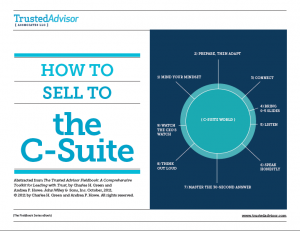Is it Ever Trustworthy to Go Around Someone to Get to the C-Suite?
 Today’s post is by Trusted Advisor Associates’ own Andrea Howe and Stewart Hirsch.
Today’s post is by Trusted Advisor Associates’ own Andrea Howe and Stewart Hirsch.
——————————
We just led a webinar on how to take a trust-based approach to building C-suite relationships. (We decided in the moment that we should call it the Hirsch and Howe Show.) There was a great question asked that we didn’t have time to adequately address, so we’re taking a moment to share our thoughts here.
For context, our webinar proposed three fundamental steps to building trust-based C-suite relationships:
- Get your “why” right: Your reason for pursing a relationship affects everything.
- Get your “what matters” right: Look thoughtfully and expansively at what would motivate them to engage with you.
- Get your “how” right: Follow trust-based best practices for (a) getting and (b) navigating the CXO conversation.
The question came up in our discussion about getting your “how” right:
What if your client below the C-level exec is blocking your access to develop a new relationship with the exec—do you ever go around him or her?
The short answer is possibly, but IF AND ONLY IF, two conditions are met:
- You have a darned good reason.
- You then do it very skillfully.
First, the darned good reason part.
The hardest work to do with this situation may not actually be the difficult conversations that are required should you choose what we’ll call a “go-around,” but rather the mental prep required to assess the situation in a trustworthy way in the first place.
What’s key is making sure you’ve asked yourself WHY you want access to the C-suite person (step 1 above), and that you’ve arrived at a good answer from a trust-building standpoint.
Let’s pause here for a quick poll: What are good reasons, in general, to pursue a C-Suite relationship? Choose all that apply:
- So we can show them our capabilities
- Because <insert competitor name> is in there
- To show them we’re better than the competition
- To secure a champion to help us expand our offerings
- Because the lower levels aren’t listening
- Because they’re the real decision-makers
- Because we’re getting nudged/pressured/pushed to have more “eminence” by our colleagues
- All of the above
- None of the above
The answer that reflects the most trustworthy approach is … drumroll … none of the above.
Think about it: every other option is actually a demonstration of high self-orientation—sometimes sneakily-so. In other words, it’s you wanting something for your benefit, not for theirs. The same is true when it comes to go-arounds.
Going a little deeper, consider what’s often at the source of (and problematic about) each of these motives:
| The Why | The Source | What’s Problematic |
| So we can show them our capabilities | · The desire to be heard, which is often far greater than our desire to listen
· Ego needs · A firm norm/assumption that this is the right thing to do |
You’re leading with what matters to you, not them.
You become a hammer searching for a nail. |
| Because <insert competitor name> is in there | · The desire to win/gain power | <Competitor name> might be doing really well by your client. If you’re a true trusted advisor, you’ll celebrate that (gasp!). |
| To show them we’re better than the competition | · The desire to win/gain power
· Ego needs |
If they’re happy with their current provider, they’re not going to believe you’re better. And you won’t convince them that you’re better by talking at them about your capabilities. |
| To secure a champion to help us expand our offerings | · The desire to win/gain power | While you care about expanding your offerings, it is highly unlikely that your client cares one iota about expanding your offerings. Leading with your desire to gain more share of the account/market because that’s what your annual goals state (for example) is all about you. Your needs aren’t their problem. |
| Because the lower levels aren’t listening | · Avoiding rejection/embarrassment
· Avoiding what might be hard work to improve these relationships |
It’s possible they’re not listening because you’re not being effective, or because they don’t trust you—a go-around therefore doesn’t address the real issue(s), and might even exasperate things. Imagine if someone tried to go around you. |
| Because they’re the real decision-makers | · The desire to win/gain power
· Ego needs |
Decisions are often left to—or strongly influenced by—those very people you are trying to go around. So the “go-around” could backfire, because the decision-maker and those in the client organization at your level are both annoyed. |
| Because we’re getting nudged/pressured/pushed to have more “eminence” by our colleagues | · Avoiding rejection/embarrassment
· Ego needs |
This is a you-centric motive, not a client-centric motive. And it’s an internal issue to address, not a client issue to address. |
If some of what’s in the table above seems harsh, well … our language may be too strong to apply to you. Or maybe not. Consider that you can be a well-meaning person of high integrity who likely still falls prey to some variation of what we’ve sketched out simply because you’re a card-carrying member of the human race. The mindsets we describe are actually common, and we’ve heard them from many humans.
Also consider that, in general, everyone’s first “why”—in other words, your rational reason for a go-around—is almost always wrong.
So, what are some good reasons for a go-around?
We brainstormed, and so far we have come up with only one clear, unambiguous reason:
The project, organization, or CXO her/himself is at serious risk—either because the lower-level person is incompetent or is sabotaging (perhaps consciously, perhaps not).
That’s it.
If your situation meets the criterion above, read the next paragraph. If not, jump two paragraphs down.
How do you go-around skillfully?
We came up with at least three best practices:
- Talk to people inside your firm about your plans so that you understand how other firm relationships with the client will be affected. You need a full understanding of just how much risk the go-around implies. The stakes could be high. A go-around that backfires, and upsets the CXO enough to call the firm’s relationship into question, could be very costly. Buy-in from your colleagues is worth seeking.
- Be transparent with the person you’re going around, either before the go-around, or immediately after, with one exception. The exception: if the person is a “bad actor”—i.e. someone whom you truly believe, based on evidence, is likely to act in an unethical way.
- Name It and Claim it with the CXO. Use caveats to show your sensitivity to the situation. Acknowledge that you’re taking this risk because you wholeheartedly believe it’s in her/his best interests, rather than yours. Let it be known that you’ve been (or will be) transparent with the person you’ve just gone-around. In other words, handle it with an “all cards on the table” kind of approach that belies your own sensitivity and vulnerability in the matter.
What are some viable alternatives to a go-around?
We brainstormed this, too, and came up with two for starters. Note they are not mutually exclusive:
- Take yourself out of it. If a relationship with “the boss” is the right thing to pursue for the right reasons, but your current relationship(s) are creating a barrier, then look for someone else in your firm who could work that C-level relationship instead of you. If it’s really about what’s best for the client, then you, personally, are not all that important.
- Work the relationship with the person who seems to be gatekeeping. This may be the hardest of all the options—maybe even harder than the go-around. Dare to put the gatekeeping issue on the table. Find out why she or he is hesitant or concerned or just plain obstructive. What’s missing in your relationship? In what ways might you not seem trustworthy enough for that person to take a risk on you? An honest dialogue could open many doors wide—including the one leading you directly to the executive. You might also discover ways to make the gatekeeper look good for being the one to bring you in to the CXO.
Now you have the Hirsch and Howe point of view on the matter. And now you know why we couldn’t adequately answer the question in the two minutes that we had on the webinar. It’s complex, with a lot of nuance, and requiring masterful mindsets as well as skill sets.
Kind of like the nature of trust.

 When it comes to trust-building, stories are a powerful tool for both learning and change. Our new
When it comes to trust-building, stories are a powerful tool for both learning and change. Our new  We’re pleased to announce the release of our latest ebook:
We’re pleased to announce the release of our latest ebook: